Nature is fascinating and often weird, it surprises us when we least expect. Some creatures use the camouflage techniques as a hunting and defense mechanism, others show everything they have - like transparent animals. Despite of what we are inclined to think, transparent and translucent animals live also on the ground, not only in the abyss of the ocean and we have visual proof of it. Nothing is photoshopped!
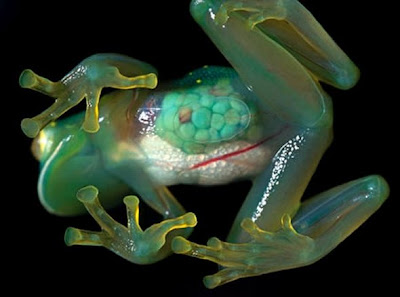
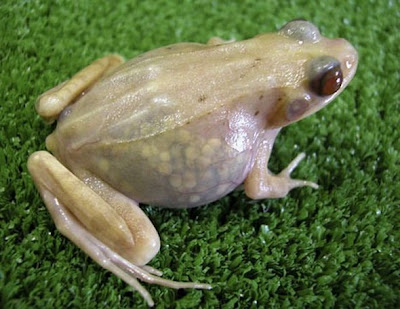

Umm, not so fast, prof… have you seen the “glass frog” (above), native to the Venezuelan rainforest? Like the transparent frogs selectively bred in the lab from generations of pale-skinned Japanese Brown Frogs, the Glass Frog’s internal organs and eggs can be seen without too much trouble. Word to Professor Sumida: take the grant money and run!

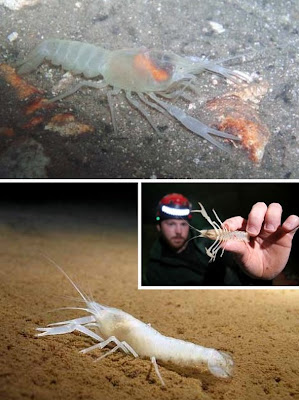

Caves are some of the darkest places on the planet – even sophisticated light-gathering instruments are unable to register a single photon in the deepest, darkest caves. Under these conditions, creatures including fish, spiders, insects and crayfish have evolved into “troglobites”: animals so precisely adapted to living in darkness that they cannot survive outside cave environments. Under such conditions, neither eyes nor pigmentation are necessary.


Slow moving, soft bodied bottom dwellers for the most part, Sea Cucumbers are an ancient lineage of sea creatures who have evolved a variety of ways to survive and thrive over hundreds of millions of years of evolution. For some Sea Cucumbers, being transparent allows them to fly
under the radar, as it were, of predators in search of a quick & easy kill.

Fund in the cold waters around Antarctica and southern South America, the crocodile icefish (Channichthyidae) feed on krill, copepods, and other fish. Their blood is transparent because they have no hemoglobin and/or only defunct erythrocytes. Their metabolism relies only on the oxygen dissolved in the liquid blood, which is believed to be absorbed directly through the skin from the water. This works because water can dissolve the most oxygen when it is coldest.
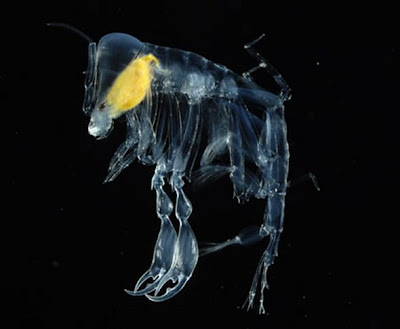
Called Phronima, this unusual animal is one of the many strange species recently found on an expedition to a deep-sea mountain range in the North Atlantic. In an ironic strategy for survival, this tiny shrimplike creature shows everything it has, inside and out, in an attempt to disappear.
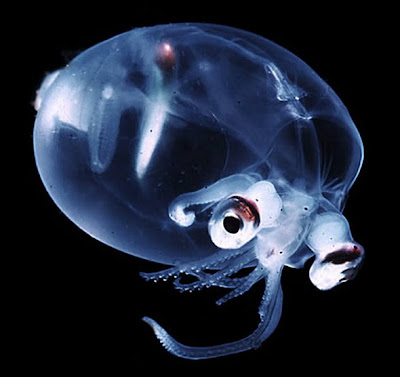
Found on the southern hemisphere’s oceans, the Glass Squid (Teuthowenia pellucida) has light organs on its eyes and possesses the ability to roll into a ball, like an aquatic hedgehog.


Siphonophores belong to the Cnidaria, a group of animals that includes the corals, hydroids, and true jellyfish. Marrus orthocanna, a deep sea siphonophore. The combined digestive and circulatory system is red; all other parts are transparent.
1. Transparent Frog



Umm, not so fast, prof… have you seen the “glass frog” (above), native to the Venezuelan rainforest? Like the transparent frogs selectively bred in the lab from generations of pale-skinned Japanese Brown Frogs, the Glass Frog’s internal organs and eggs can be seen without too much trouble. Word to Professor Sumida: take the grant money and run!
2. Transparent Cave Crayfish



Caves are some of the darkest places on the planet – even sophisticated light-gathering instruments are unable to register a single photon in the deepest, darkest caves. Under these conditions, creatures including fish, spiders, insects and crayfish have evolved into “troglobites”: animals so precisely adapted to living in darkness that they cannot survive outside cave environments. Under such conditions, neither eyes nor pigmentation are necessary.
3. Transparent Sea Cucumber


Slow moving, soft bodied bottom dwellers for the most part, Sea Cucumbers are an ancient lineage of sea creatures who have evolved a variety of ways to survive and thrive over hundreds of millions of years of evolution. For some Sea Cucumbers, being transparent allows them to fly
under the radar, as it were, of predators in search of a quick & easy kill.
4. Transparent Icefish

Fund in the cold waters around Antarctica and southern South America, the crocodile icefish (Channichthyidae) feed on krill, copepods, and other fish. Their blood is transparent because they have no hemoglobin and/or only defunct erythrocytes. Their metabolism relies only on the oxygen dissolved in the liquid blood, which is believed to be absorbed directly through the skin from the water. This works because water can dissolve the most oxygen when it is coldest.
5. Transparent Amphipod

Called Phronima, this unusual animal is one of the many strange species recently found on an expedition to a deep-sea mountain range in the North Atlantic. In an ironic strategy for survival, this tiny shrimplike creature shows everything it has, inside and out, in an attempt to disappear.
6. Transparent Squid

Found on the southern hemisphere’s oceans, the Glass Squid (Teuthowenia pellucida) has light organs on its eyes and possesses the ability to roll into a ball, like an aquatic hedgehog.
7. Transparent Siphonophores


Siphonophores belong to the Cnidaria, a group of animals that includes the corals, hydroids, and true jellyfish. Marrus orthocanna, a deep sea siphonophore. The combined digestive and circulatory system is red; all other parts are transparent.







